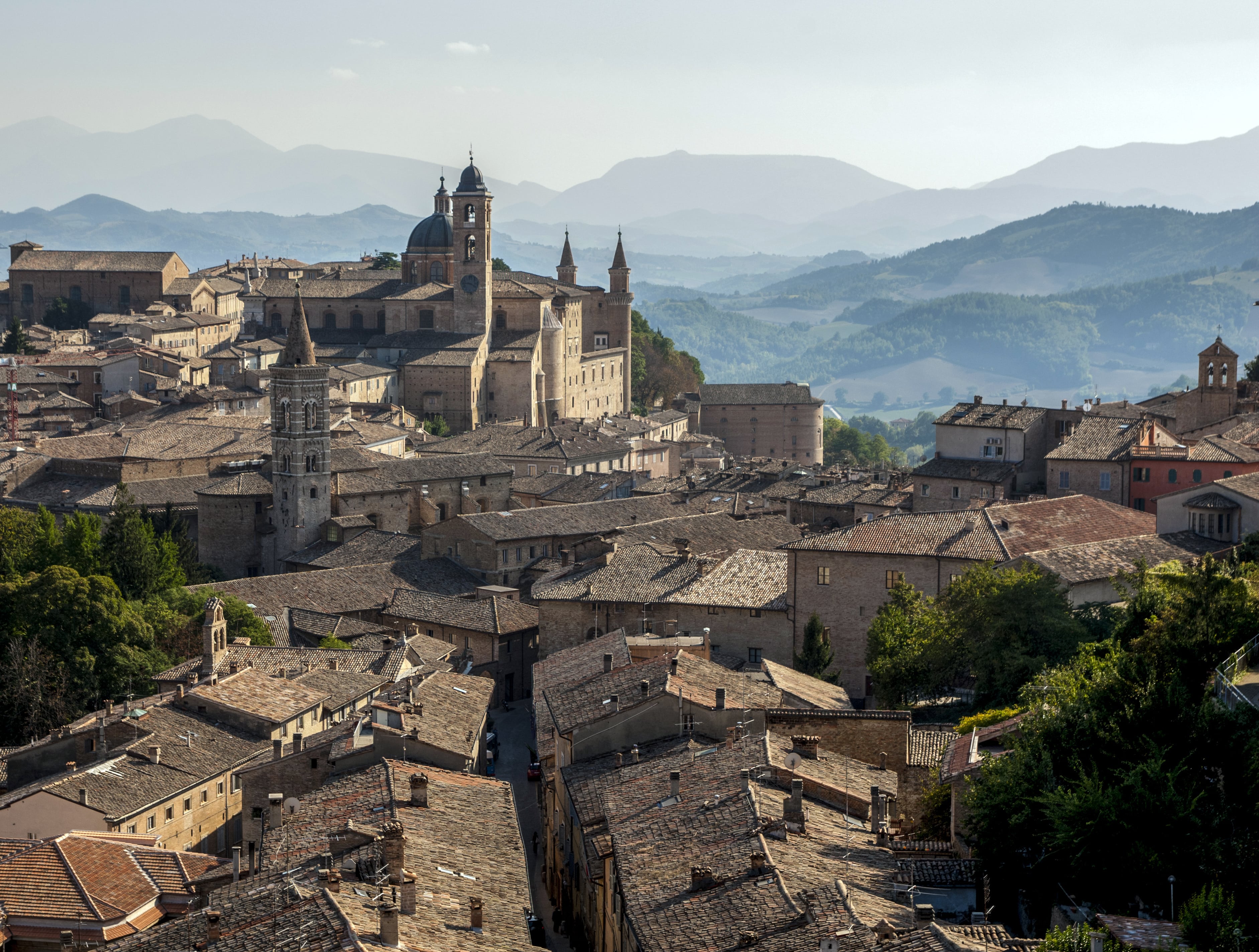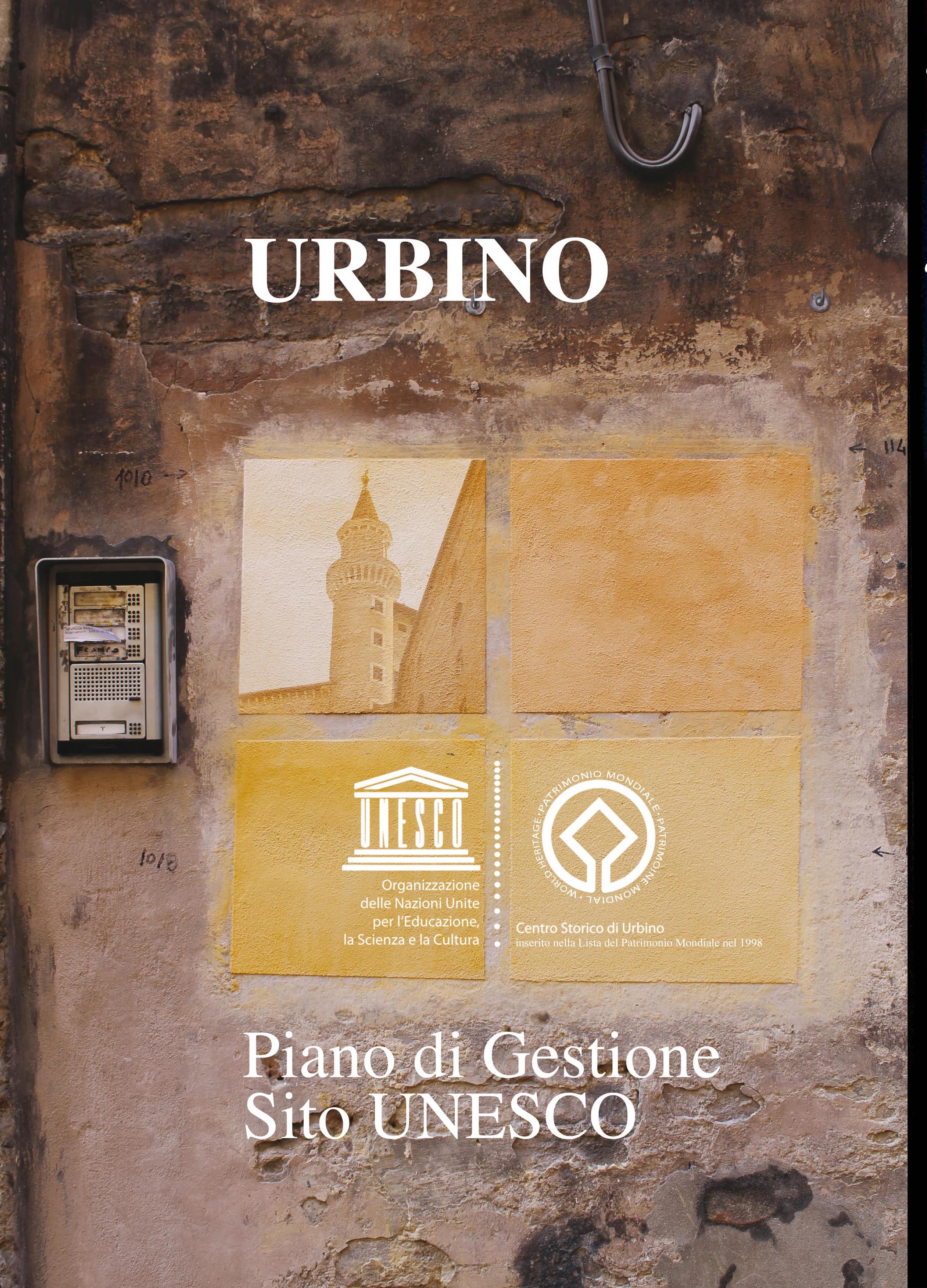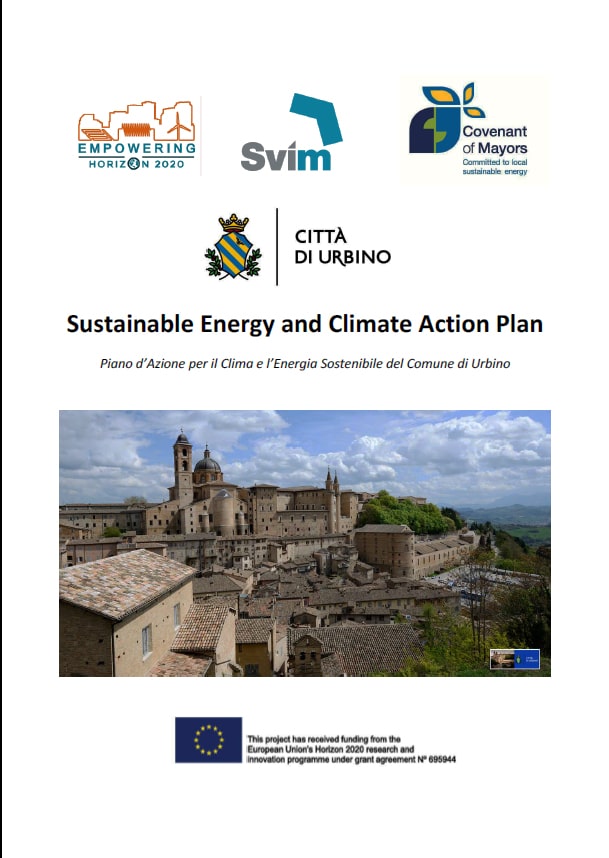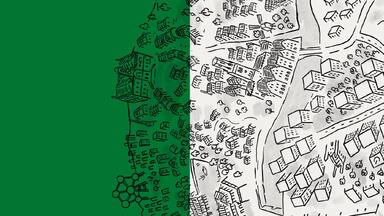Improving the environmental, cultural and social sustainability of the Historic Centre of Urbino (Italy)
Through a series of strategic actions, Urbino has sought to improve its environmental sustainability and promote climate change mitigation and adaptation. An update of the management plan is currently under way in order to create an integrated, holistic view of the World Heritage site, taking into consideration its strengths and challenges.
About Urbino
Urbino is a historic city located in the region of Marche, in central Italy. The city is in the central Apennines, at an altitude of 485 metres above the sea level. With a size of over 220 km2, the municipality is home to just under 14,000 residents. In addition, Urbino is also home to approximately 15,000 university students who come to the city every year and are mostly housed within the historic centre. The Historic Centre of Urbino was inscribed on the World Heritage List in 1998 under criteria (ii) and (iv).
"The small Italian hill town of Urbino became, for a short time during the Renaissance era, one of the major cultural centres in Europe. Today, the historic centre is defined by its Renaissance walls that survive virtually intact, complete with bastions. Within these walls, several buildings of extraordinary quality have been retained such as the Ducal Palace, the cathedral, the Monastery of Santa Chiara and a complex system of oratories. Urbino represents a pinnacle of Renaissance art and architecture, harmoniously adapted to its physical site and to its medieval precursor in an exceptional manner."

According to the site manager of the World Heritage property, the strengths of the site are strongly linked to its rich cultural heritage and unique geographical position. They include the monumental and built heritage, urban identity, views, parks, agricultural landscape, traditional and organic agricultural practices, and traditional crafts such as bookbinding, engraving and printing.
On the other hand, the site is facing a number of challenges, such as:
- Low levels of awareness about heritage values amongst the local population (including its Outstanding Universal Value), leading to a lack of care and capacity to interpret heritage as an opportunity for local development.
- Social changes, including aging and transient populations.
- Transformation of the rural landscape, through mechanisation of agricultural activities and progressive abandonment and re-naturalisation of traditional agricultural landscapes.
- Climate change.
Climate-related impacts
In the region of Marche, weather records from 1950 until our days show an increase of the mean temperature and decrease in precipitation. Since 2005, the Regional Department of Civil Protection has registered more than 30 extreme weather events within the Marche, mostly related to extreme rainfall and flooding, with deep impacts on economic and social activities. Additionally, urban areas are especially affected by heat waves and water scarcity.
Other potential impacts of climate change identified by the LIFE SEC ADAPT PROJECT include: reduced water availability and quality, increased risk of landslides, flash mud/debris flows, rock falls and flash floods; increased pressure on urban and rural infrastructures and transport network: and reduced access and disruptions to human settlements and socio-economic activities.
The risks associated with extreme weather events and climate change are worsened by rapid and unevenly urbanisation and the social dynamics such as the aging of the population. These factors will contribute to further increase the vulnerability of the city to climate change.
Source: LIFE SEC ADAPT PROJECT, 2020, Upgrading Sustainable Energy Communities in Mayor Adapt initiative by planning Climate Change Adaptation strategies.
Climate action solutions and strategies
In recent years, the Municipality of Urbino has carried out several actions to improve the environmental, cultural, and social sustainability of the city. These efforts will be included in the ongoing revision of the World Heritage Management Plan. Firstly, after adhering to the European Covenant of Mayors for Climate and Energy, the city has developed a Sustainable Energy and Climate Action Plan (SECAP). The plan includes a baseline review with an inventory of emissions and climate risk and vulnerability assessment, as well as strategies for Climate Change Mitigation and Climate Change Adaptation. The World Heritage site plays a key role in the plan, especially in the section related to adaptation, concerning the energy efficiency of the buildings in the historic centre. After adhering to the European Covenant of Mayors in 2010, in 2019 Urbino fulfilled this commitment and reduced its CO2 emissions by 25% .
Most recently, the World Heritage site of the Historic Centre of Urbino is carrying out an update of the World Heritage Management Plan. The update aims to protect and enhance the Outstanding Universal Value of the site while reducing its environmental impact, promoting climate adaptation and mitigation, guiding sustainable development, and involving the local communities.
The current Management Plan for the Historic Centre of Urbino was approved on 3 December 2013. It was based on an earlier 2003 Management Plan and its 2011 update. The 2013 Management Plan was funded by the Italian Ministry of Cultural Heritage under the line of grants devoted to UNESCO World Heritage sites (National Law N. 77/06). The plan was developed by the Municipality of Urbino in collaboration with the Italian Ministry of Culture – Superintendence of Marche Region, Provinces of Pesaro e Urbino, Mountain Union Alta valle del Metauro, University of Urbino Carlo Bo, Archdioceses of Urbino, Urbania and S. Angelo in Vado, and ISA - Urbino Book School - Art Hight School.
The update is based on the 2013 Management Plan and responds to the recommendations of the ICOMOS Report dated December 2016. The update of the Management Plan aims to preserve and enhance the Outstanding Universal Value of the property, raise awareness about the site’s cultural values, integrate cultural heritage in the overall vision for the city and collaboratively design a path forward with the local communities. The process for the update of the Management Plan started in 2020 and is expected to come to an end in 2021.
The update will include the Urbino Climate Change Adaptation and Mitigation Plan and the Disaster Risk Management Plan, which includes an update of the Civil Protection Plan and a disaster risk analysis and reduction plan. It will also employ the approach of the Historic Urban Recommendation in the identification and protection of the historical layers of the city, and the integration of heritage conservation with short- and long-term urban development policies. It will address three key topics:
- Climate change prevention, adaptation and mitigation: involving actions to minimise the environmental impact of the city and adapt to the inevitable reality of climate change.
- Heritage-based local development: the aim is to make cultural heritage the main driver for sustainable local development.
- Sustainable agriculture: supporting and enhancing traditional and organic agricultural practices can help promote economic development, preserve the historic landscape and improve soil conservation.
The initiative is developed by a consortium of partners, including local, regional, and national authorities, and cultural and educational institutions. The main project partners are the Italian Ministry of Culture, Municipality of Urbino, University of Urbino Carlo Bo, Marche Region, Provinces of Pesaro and Urbino, Archdiocese of Urbino, Urbania and Sant’Angelo in Vado, National Gallery of the Marche: Ducal Palace of Urbino, Raffaello’s House - Raffaello Academy, Erdis - Regional Body for the Right to Education, Alta Valle del Metauro Mountain Union; Montefeltro Mountain Union; Catria and Nerone Mountain Union; Valmarecchia Union of Municipalities; Local Action Group Montefeltro Development; Local Action Group Valli Marecchia and Conca. Other stakeholders include local associations, educational institutions, and neighbouring municipalities.
During the period of implementation of the current World Heritage Management Plan, the project team learned the importance of raising awareness and building knowledge amongst the residents on World Heritage values and their attributes and involving them in the conservation and management processes. Consequently, the review process will include a community consultation process, carried out by the University of Urbino Carlo Bo.
The consultation will use a variety of tools including working tables, questionnaires in-person and virtual meetings, and an online communications campaign through the website and social media channels of the Administration.
In-person surveys will be carried out by local students as an internship experience within their academic programme. The consultation will seek to understand the awareness of the local population about World Heritage and engage stakeholders in the update of the management plan.
Through the development of the Sustainable Energy and Action Plan and update of the World Heritage Management Plan, Urbino aims to address the challenges facing the city, such as climate change and environmental sustainability, and to propose a path for heritage-centred sustainable local development, designed in a collaborative way with the local communities. In doing so, Urbino aims to ensure the sustainability and habitability of the historic town for the years to come.
Source: Ms Luana Alessandrini, Urbino World Heritage Office, Municipality of Urbino, 2021.
Contribution towards global goals
How does this case study contribute to the global commitments of sustainable development, climate change action and heritage conservation?
Sustainable development
The initiative aims to contribute towards sustainable development by addressing the following Sustainable Development Goals:

Target 2.4: the initiative aims to implement resilient agricultural practices that increase productivity and production, help maintain ecosystems, strengthen capacity for adaptation to climate change and progressively improve land and soil quality, by promoting traditional and organic agricultural practices.

Target 8.9: the initiative aims to promote sustainable tourism that creates jobs and promotes local culture and products.

Target 11.3: the initiative aims to enhance inclusive and sustainable urbanisation by promoting participatory processes and heritage conservation.
Target 11.4: the initiative aims to protect and safeguard the world’s cultural and natural heritage.
Target 11.6: the initiative aims to reduce the adverse per capita environmental impact of the city of Urbino.

Target 13.1: the initiative aims to strengthen resilience and adaptive capacity to climate-related hazards and natural disasters.

Target 17.17: the initiative aims to encourage and promote effective public, public-private and civil society partnerships, building on the experience and resourcing strategies of partnerships.
Climate change
Urbino is vulnerable to natural disasters and climate change. In the past 70 years, weather records show increasing temperatures and reducing rainfall. Extreme events are mostly related to extreme rainfall and flooding, which impact economic and social activities
Reduce emissions by adhering to strict climate mitigation targets and developing a Sustainable Energy and Climate Action Plan.
Minimising climate risk and vulnerability by carrying out assessments and developing strategies for climate change adaptation.
Integrating climate action into the frameworks of World Heritage site management.
Historic Urban Landscape
The initiatives developed by the city of Urbino to improve its environmental, cultural and social sustainability aim to contribute to the implementation of the approach of the 2011 Recommendation on the Historic Urban Landscape by:
- integrating heritage conservation in urban development and planning policies,
- harnessing the potential of cultural heritage to contribute to sustainable urban development,
- defining a clear vision for the future of the city through a collaborative process involving the local communities,
- enhancing and preserving Urbino’s cultural heritage, and
- strengthening the relationship between the historic town and surrounding agricultural landscape.
Learn more
Discover more about the details of the case study and the stakeholders involved.
To learn more
- Consult the World Heritage management plan for the Historic Centre of Urbino (English / Italian) and read about its update.
- Read about the actions taken by the World Heritage site to minimise its environmental impact.
- Learn more about the site on the website of the Italian Ministry of Culture.
- Read about the European project Life Sec Adapt to promote climate change mitigation and adaptation.
- Watch the video presentation of the Climate Change Adaptation Plan (in Italian).
- Watch “Urbino: un questionario sul Piano di Gestione del Sito Unesco”, an interview on the regional television channel with the project team carrying out the update of the management plan (in Italian).
- Watch “Il Piano di Gestione del Sito UNESCO Centro storico di Urbino”, an educational video for children made by the Municipality of Urbino (in Italian)
Contact
Ministry of Culture – National Focal Point
- Email: adele.cesi@beniculturali.it
- Address: Via del Collegio Romano 27, c.a.p. 00186 Roma
- Website: https://www.unesco.beniculturali.it/struttura/
Urbino World Heritage Office
- Email: lalessandrini@comune.urbino.ps.it
- Address: Via Puccinotti n. 33, c.a.p. 61029 Urbino
- Website: http://www.comune.urbino.pu.it/
Credits
© UNESCO, 2022. Project team: Jyoti Hosagrahar, Alba Zamarbide, Carlota Marijuán Rodríguez.Cover image: Fridays for Future Urbino. © Luana Alessandrini, Comune di Urbino.
Note: The cases shared in this platform address heritage protection practices in World Heritage sites and beyond. Items being showcased in this website do not entail any type of recognition or inclusion in the World Heritage list or any of its thematic programmes. The practices shared are not assessed in any way by the World Heritage Centre or presented here as model practices nor do they represent complete solutions to heritage management problems. The views expressed by experts and site managers are their own and do not necessarily reflect the views of the World Heritage Centre. The practices and views shared here are included as a way to provide insights and expand the dialogue on heritage conservation with a view to further urban heritage management practice in general.



